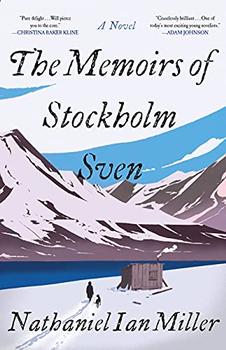Summary | Excerpt | Reviews | Beyond the book | Read-Alikes | Genres & Themes | Author Bio

The Memoirs of Stockholm Sven by Nathaniel Ian Miller opens with a brief prologue narrated in the voice of the protagonist, Sven. His prose is unassumingly candid, and his dry, disclaimer-like tone does little in the way of arousing anticipation for a grand adventure. What he draws upon instead is the reader's curiosity. For even a character as modest as Sven would realize that the casual mention of a certain colorful pejorative within the second sentence, involving a predilection for innocent sea mammals and deviant sex acts, is bound to give rise to the question of just how a man who claims to have lived so mundanely could earn so unflattering a nickname. Herein lies the reader's introduction to the book's understated charm: It is the story of an ordinary human whose unorthodox lifestyle achieves its own legendary notoriety over time. Through the veneer of the commonplace, the reader senses an undercurrent of the unexpected with each new development of Sven's life.
Sven wastes no time addressing the reader with a summary of the presumed facts: At the age of 32, he moved to a remote Arctic archipelago called Spitsbergen (see Beyond the Book). It was 1916, the height of the seemingly distant First World War. He suffered injuries in a mining accident and later made the long journey to an even more remote region just a few degrees below the North Pole to live and trap on the untouched grounds. As though reading our minds, he acknowledges without answering the inevitable question of how anyone would willingly choose to seek out such daunting geographical desolation, a realm beyond the normal purview or aspiration of the vast majority of humans. Sven states he was almost never alone in the barren landscape of ice and snow, and with that claim we are drawn yet further into this curiosity of a world, sifting through exaggerations and embellishments to discover the true adventure that lies at the heart of a lifetime of experiences.
The book is divided into five parts, each of which portrays a unique epoch of Sven's life and is defined by the individuals with whom he chiefly interacts during the given timeframe. Starting from the first genuine friend he makes in Part Two at the otherwise inhospitable mining town of Longyearbyen, it becomes clear that the influence of the few recurring people in his life grows cumulatively over time. Like the unstirred mountains ever present in the background of the various landscapes he discerns in his travels, it is the foundational existence of such companions and allies—even when not immediately felt—that establishes a kind of earthly mythology in which people as seemingly ordinary as a Scottish geologist, a stoic Finnish trapper and a runaway desperate to escape an oppressive past become his connection to something grander and more compelling than the majestic physical wonders of Spitsbergen. As their familiarity and emotional support deepens, the very mention of their names elicits a sense of comfort. Their sporadic, unannounced appearances throughout Sven's life to save him from himself manifest as reunions of joy, each a reassurance that somehow, everything is going to be alright.
The focus of events in Part Four shifts without warning from the setting of Sven's solitary cabin in the hunting grounds of northern Raudfjorden to the comparatively bustling town of Pyramiden, a Soviet mining outpost. After around four years of unmitigated solitude and reflection in the Arctic wilderness, he plunges unwittingly into the apex of human melodrama. His arrival in Pyramiden and the subsequent observations of and interactions with its residents draw Sven's attention toward a string of issues circling around unrequited love, lust, marital infidelity, sex, passion and revenge.
The final section sees an equally abrupt return to the book's original focus on Sven's relatively peaceful but not complete isolation in Raudfjorden. Without giving away any spoilers, by the time the reader reaches the epilogue, around three decades have transpired. True to the story's undercurrent of the unexpected, Sven finds himself once more in the unknown. World War II has just ended, though he is witness only to its aftermath. Sven no longer addresses the reader, but the letter he holds in his hand may as well have been written for each of us. Its contents and the name signed at the end will place an immediate smile upon the face of anyone who has journeyed through the novel's pages with him.
![]() This review was originally published in The BookBrowse Review in November 2021, and has been updated for the
October 2022 edition.
Click here to go to this issue.
This review was originally published in The BookBrowse Review in November 2021, and has been updated for the
October 2022 edition.
Click here to go to this issue.

If you liked The Memoirs of Stockholm Sven, try these:

by Andrew Krivak
Published 2020
In an Edenic future, a girl and her father live close to the land in the shadow of a lone mountain.

by Fredrik Backman
Published 2018
The #1 New York Times bestselling author of A Man Called Ove returns with a dazzling, profound novel about a small town with a big dream - and the price required to make it come true.
Your guide toexceptional books
BookBrowse seeks out and recommends the best in contemporary fiction and nonfiction—books that not only engage and entertain but also deepen our understanding of ourselves and the world around us.